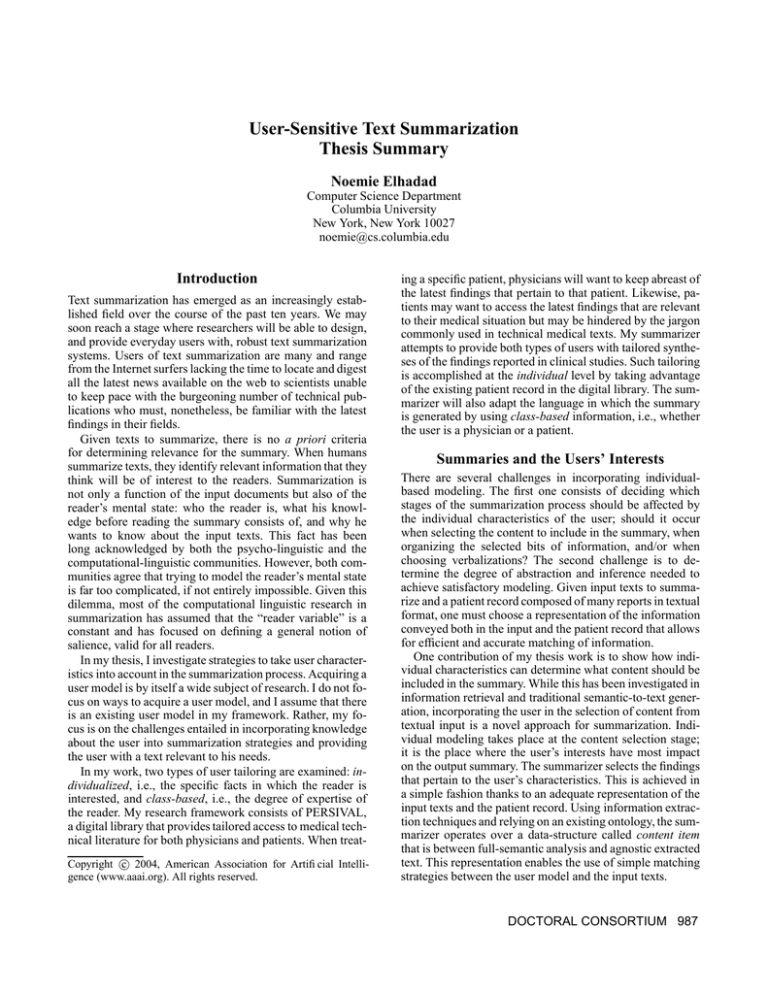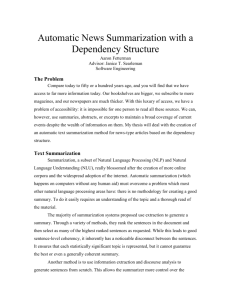
User-Sensitive Text Summarization
Thesis Summary
Noemie Elhadad
Computer Science Department
Columbia University
New York, New York 10027
noemie@cs.columbia.edu
Introduction
Text summarization has emerged as an increasingly established field over the course of the past ten years. We may
soon reach a stage where researchers will be able to design,
and provide everyday users with, robust text summarization
systems. Users of text summarization are many and range
from the Internet surfers lacking the time to locate and digest
all the latest news available on the web to scientists unable
to keep pace with the burgeoning number of technical publications who must, nonetheless, be familiar with the latest
findings in their fields.
Given texts to summarize, there is no a priori criteria
for determining relevance for the summary. When humans
summarize texts, they identify relevant information that they
think will be of interest to the readers. Summarization is
not only a function of the input documents but also of the
reader’s mental state: who the reader is, what his knowledge before reading the summary consists of, and why he
wants to know about the input texts. This fact has been
long acknowledged by both the psycho-linguistic and the
computational-linguistic communities. However, both communities agree that trying to model the reader’s mental state
is far too complicated, if not entirely impossible. Given this
dilemma, most of the computational linguistic research in
summarization has assumed that the “reader variable” is a
constant and has focused on defining a general notion of
salience, valid for all readers.
In my thesis, I investigate strategies to take user characteristics into account in the summarization process. Acquiring a
user model is by itself a wide subject of research. I do not focus on ways to acquire a user model, and I assume that there
is an existing user model in my framework. Rather, my focus is on the challenges entailed in incorporating knowledge
about the user into summarization strategies and providing
the user with a text relevant to his needs.
In my work, two types of user tailoring are examined: individualized, i.e., the specific facts in which the reader is
interested, and class-based, i.e., the degree of expertise of
the reader. My research framework consists of PERSIVAL,
a digital library that provides tailored access to medical technical literature for both physicians and patients. When treatc 2004, American Association for Artificial IntelliCopyright gence (www.aaai.org). All rights reserved.
ing a specific patient, physicians will want to keep abreast of
the latest findings that pertain to that patient. Likewise, patients may want to access the latest findings that are relevant
to their medical situation but may be hindered by the jargon
commonly used in technical medical texts. My summarizer
attempts to provide both types of users with tailored syntheses of the findings reported in clinical studies. Such tailoring
is accomplished at the individual level by taking advantage
of the existing patient record in the digital library. The summarizer will also adapt the language in which the summary
is generated by using class-based information, i.e., whether
the user is a physician or a patient.
Summaries and the Users’ Interests
There are several challenges in incorporating individualbased modeling. The first one consists of deciding which
stages of the summarization process should be affected by
the individual characteristics of the user; should it occur
when selecting the content to include in the summary, when
organizing the selected bits of information, and/or when
choosing verbalizations? The second challenge is to determine the degree of abstraction and inference needed to
achieve satisfactory modeling. Given input texts to summarize and a patient record composed of many reports in textual
format, one must choose a representation of the information
conveyed both in the input and the patient record that allows
for efficient and accurate matching of information.
One contribution of my thesis work is to show how individual characteristics can determine what content should be
included in the summary. While this has been investigated in
information retrieval and traditional semantic-to-text generation, incorporating the user in the selection of content from
textual input is a novel approach for summarization. Individual modeling takes place at the content selection stage;
it is the place where the user’s interests have most impact
on the output summary. The summarizer selects the findings
that pertain to the user’s characteristics. This is achieved in
a simple fashion thanks to an adequate representation of the
input texts and the patient record. Using information extraction techniques and relying on an existing ontology, the summarizer operates over a data-structure called content item
that is between full-semantic analysis and agnostic extracted
text. This representation enables the use of simple matching
strategies between the user model and the input texts.
DOCTORAL CONSORTIUM 987
At the current stage of my thesis work, I have designed
and implemented a multi-document summarizer which generates tailored summaries of clinical studies (Elhadad et al.
2004). It is integrated into the overall PERSIVAL digital library. It tailors its output based on the record of the patient
under care. Using information extraction techniques, content items are extracted at the sentence level from the input
articles. Each content item represents a finding reported in
a clinical study. It contains extracted pieces of information
(namely, a set of parameters and a relation which links them)
and meta-information (such as article and sentence numbers
in which the finding was reported). The content items are
then filtered against the patient record using a simple strategy. The strategy was reviewed and approved by the medical
experts working on the PERSIVAL project. Next, the content items are organized: they are first merged into blocks of
semantically related items using clustering. The similarity
measure used for clustering is based on features of the content items: the more parameters two content items have in
common, the more similar they are. Repetitions are identified as identical content items and contradictions are identified as content items with identical parameters but with
contradictory relations. Once the blocks are produced, each
block is then assigned a priority weight based on salient features of its content items. This determines the order in which
the blocks will be displayed in the summary. The summary
itself is obtained by using phrasal generation, relying on the
verbalization used by the input articles of the different content items. The resulting summary is a coherent and fluent
re-generated (not extracted) text. The filtering against the
patient record allows for the individual tailoring. To date the
language the summarizer generates is targeted at physicians.
I now plan to focus on generating summaries that are appropriate to users with a different level of expertise, such as
patients.
Summaries and the Users’ Expertise Level
I model the generation as a text simplification process. Given
a summary originally produced for expert users, the goal
is to generate a simplified version readable by lay users.
Text simplification is an incipient field of computational linguistics, and many challenges presently exist. While most
of the content is already selected in the original summary,
not all the pieces of information should be included in the
simplified version. Some details might be too technical for
instance, and including them in a simplified version would
only confuse the reader. Conversely, it might be necessary
to introduce additional content such as background knowledge to enhance the reader’s comprehension. Wording is obviously affected by the simplification process, whether one
looks at the syntactic or lexical level.
I propose to approach the simplification process as applying a set of rewriting rules which affect both the technical
lexical items and the technical sentences as whole. I plan
to learn the rewriting rules by relying on a comparable corpus of technical texts and their simplified versions targeted
at lay users. Lexical rules will include term simplification
and definition insertion, while sentence rules will consist of
paraphrasing the input sentence into a lay equivalent.
988
DOCTORAL CONSORTIUM
The first step is to collect instances of technical/lay sentence pairs from the comparable corpus automatically so
that learning on many instances can be done. In preliminary
work (Barzilay & Elhadad 2003), we have designed an algorithm for aligning sentences in comparable texts, such as
encyclopedia articles written for children and adults. Our
method relies on a simple lexical similarity measure and
the automatically identified topical structure of typical articles. However, in the medical domain, new challenges arise:
there is very little lexical similarity between technical and
lay texts, and the topical structure is harder to induce automatically. I plan to investigate ways to adapt the algorithm
to these new challenges.
The next step will be to learn the actual rewriting rules.
For lexical rewriting rules, I will investigate ways to choose
between alternative verbalizations of technical terms based
on their frequency counts in lay and technical corpora. I plan
to research when a definition is needed for a specific term
and how it can be inserted into the simplified text. At the sentence level, I plan to investigate methods for unsupervised
acquisition of the rewriting rules based on the automatically
aligned comparable corpus.
Finally, I plan to evaluate my summarizer overall both
with physicians and lay users. For physicians, I plan to assess whether the summaries help them access relevant information efficiently. Working with cognitive scientists members of the PERSIVAL team, we have set up a set of medical
scenarios in which physicians have to find some information
in the literature in order to treat a specific patient. We plan
to compare how easy it is for the physicians to find the relevant information when presented with (a) the summarizer’s
output, (b) a modified version of the summarizer which does
not tailors for individual content, or (c) results of a search.
For lay users, I plan to evaluate whether their comprehension
is eased by the simplification. In the planned user study, lay
users will be presented with a technical summary or its lay
version and a set of comprehension questions. To date, I have
evaluated individual components of my summarizer, such as
the content extraction and the content filtering module. The
evaluation of the sentence alignment and the validity of the
rewriting rules is planned work.
Acknowledgments
I would like to thank Kathleen McKeown, Regina Barzilay
and Smaranda Muresan for the useful discussions. This work
is supported by the National Science Foundation Digital Library Initiative Phase II Grant No. IIS-98-17434.
References
Barzilay, R., and Elhadad, N. 2003. Sentence alignment for monolingual comparable corpora. In Proceedings of Empirical Methods in Natural Language Processing (EMNLP), 25–32.
Elhadad, N.; Kan, M.-Y.; Klavans, J.; and McKeown, K.
2004. Customization in a unified framework for summarizing medical literature. Journal of Artificial Intelligence
in Medicine. to appear.





